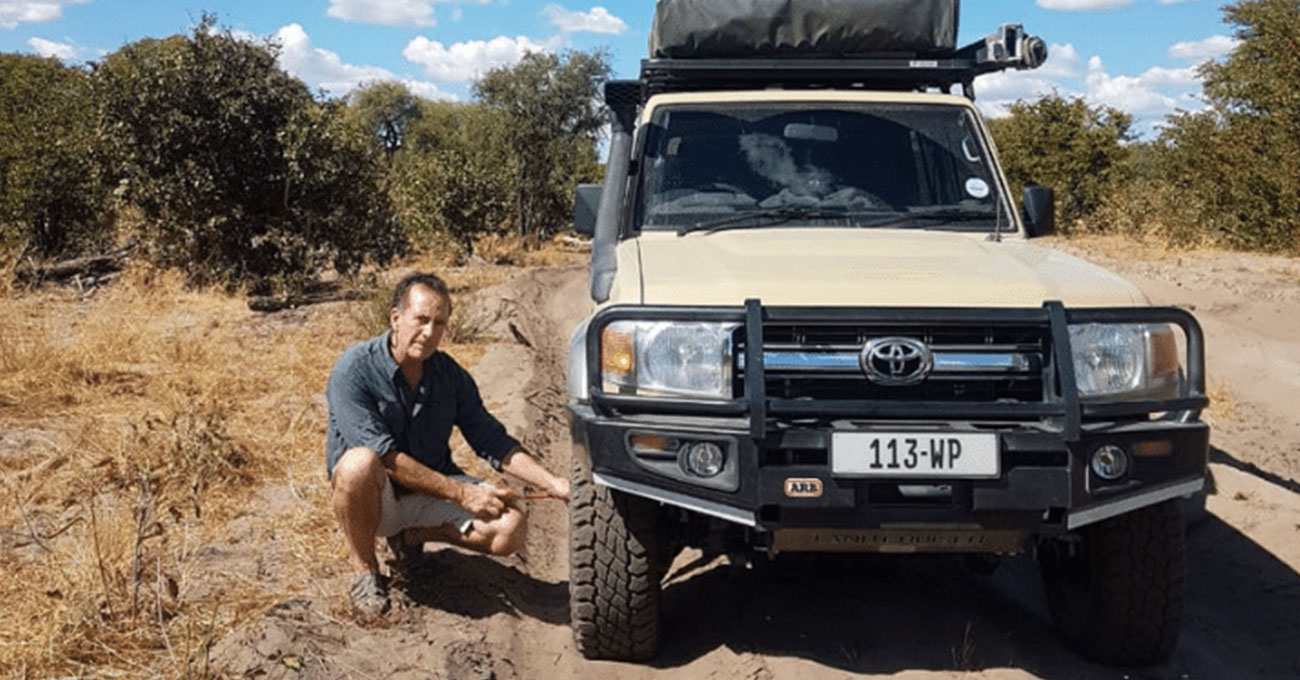BE AN INDEPENDENT TRAVELLER: INTERVIEW WITH PAUL MARSH PART 3
To all explorers, adventurers and 4×4 enthusiast—this one’s for you.
In this month’s final Interview with Paul Marsh, we take a deeper dive into his world of overland vehicle modification, customisation and builds. Paul also shares with us some helpful expedition preparation advice and a few more useful tips and facts to take with you on your overland adventure travel journey.
What’s your number one piece of advice on a self-drive safari in Africa?
“The most important aspect is to take on the responsibility of your own wellbeing. If you’re going to a company that’s just going to hand you the keys to a vehicle, you need to take an active role in preparing for your trip. Take on the responsibility of getting to know as much as you can about your trip ahead of time. Watch YouTube videos, speak to people and get some training so that when you head out on your trip, you have the confidence and knowledge to help yourself out of a situation instead of relying on someone else to help you. Be an independent traveller—the more independent you are, the more confident you’ll feel exploring remote areas.”
What’s the fundamental difference between hiring a 4×4 safari vehicle from a self-drive company and hiring one from a car rental service?
“When hiring a vehicle through a self-drive company like TechPro Safari, you are getting a bespoke service in planning your trip. It’s going to be a hand holding experience because not only are they going to help prepare your itinerary, they’re going to ensure that the experience you have with the vehicle, the training beforehand as well as the hand over procedure are what you need to carry out your trip in the best way possible. You are paying for this service so it’s important to know what to expect.”
“When you hire a vehicle from a car rental company, there’s less interaction with the client. They are not planning your trip; they don’t take on that responsibility and you are not paying for that service either. What is important is to know where you will be going and to ensure you have the correct equipment and experience to undertake this trip.”
“Some companies limit the equipment they supply and fit to vehicles; others charge extra for additional equipment like a winch or jerry cans. A lot of the time hiring a vehicle may come across as the cheaper option, but with all the added extras, you could land up paying more compared to a self-drive company’s vehicle, which has much higher specs and a lot more inclusions. Take a look at TechPro Safaris fleet for instance, all equipment is included by default, and there are no hidden costs. It’s your responsibility to make sure you have what you need.
“Sadly, people don’t know what they don’t know, and I use this term often. People go out and hire a vehicle from a rental company in total ignorance and trust that what they’re getting is what they should have. They go into it with no real experience, no real support and sometimes without the right equipment. All this could tarnish what could be an amazing experience.”
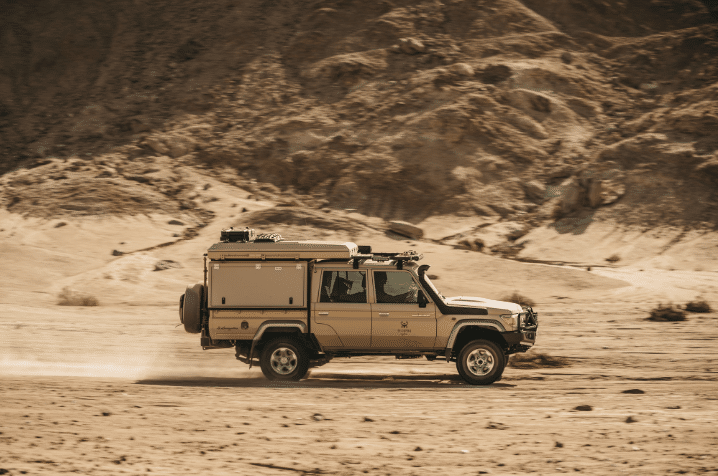
“If you’re looking to explore Africa, I think it’s important to look at your options; what are you prepared to spend and what are you getting out of your money. Ask yourself, what are your values and priorities. What are your needs, and what is your experience. Once you know your needs and wants, that’s when you can look at self-drive companies and compare them apart from hire companies. Your experience and your time available together with your budget are what you have to balance out to make good decisions.”
“With some hire companies, you can request to hire extra equipment like satellite phones. If they don’t supply this, then take responsibility and hire one from an outside company. Remember, you are in charge of your safety. My highest value is safety; I have seen where it all goes wrong; I have made life-threatening mistakes and bad decisions. It has taught me that more knowledge is critical to safety on any expedition. I will always travel with a satellite phone, I owe my life to one when I had a near fatal accident in South America, 4 days from the end of a 3-month expedition. Looking back on that event showed me how I lead myself into a set of circumstances that were heavily stacked against me.”
What base vehicle did you use for TechPro Safari’s fleet and why?
“TechPro Safari’s fleet is made up predominantly of the Toyota Land Cruiser 79 series with a recent addition of the Toyota Hilux.”
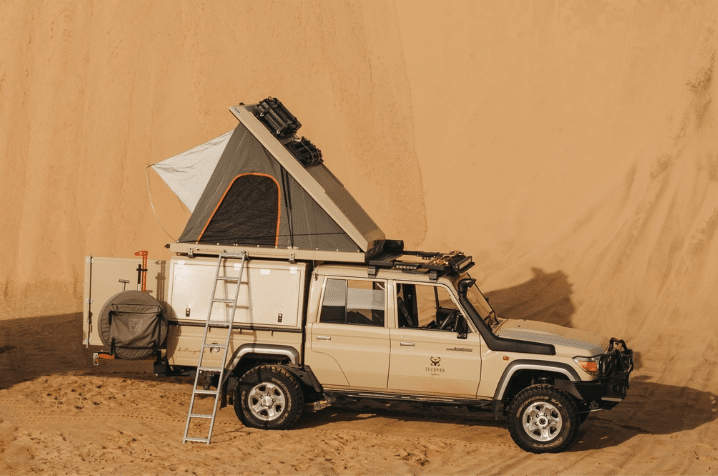
“When it came to building TechPro Safari’s fleet, we looked for the most reliable and robust vehicle. A vehicle with a good network of support and that was easy to maintain and repair. Toyota, in my opinion, fits this need, especially the Land Cruiser with the strong reliable and simple 4.2 L Diesel engine.”
“We chose the Double cab 79 series for space and load carrying ability. Fitting a canopy to the rear load area gives you easy access to all your equipment. Access is an important and convenient aspect to using your equipment with the least amount of fuss.”
“The Toyota Hilux was brought in to provide clients with the option of hiring an automatic vehicle—because we don’t get automatics in the double cab Land Cruisers. So, the Hilux fills a niche in the market, and they’re great vehicles, just not as strong and robust as the double cab Land Cruiser. We applied a similar approach to fitting out the load area of the Hilux. With a smaller canopy, you have less space to carry extra luggage, so in my opinion, the Hilux is great for 3 people. The automatic gearbox will perform exceptionally well in difficult conditions. Driving the Hilux will be more like an SUV and as capable as the Land Cruiser.
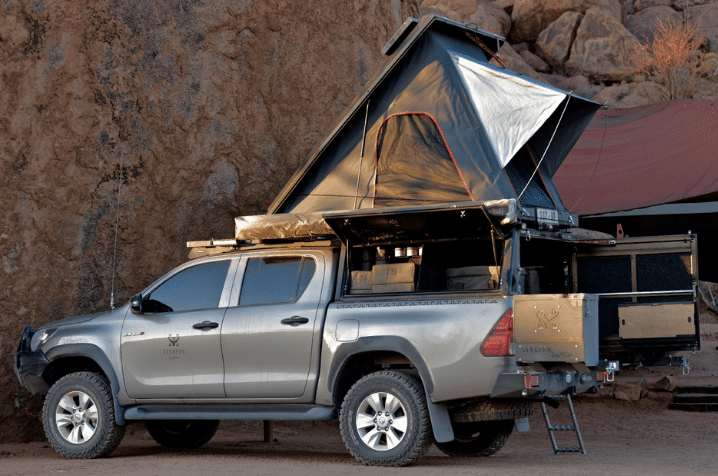
You built and continue to add to TechPro Safaris fleet. What were some of the top modifications made to their vehicles?
“There are a few I will mention. For one, they’ve put some great rooftop tents, specifically the clamshell design which takes all of 60 seconds to set up. This model of tent allows us to fit a solar panel which adds extra charge into the auxiliary battery as well as fit a set of recovery Max Trax to the top of it for easy access when stuck in sand or mud. “
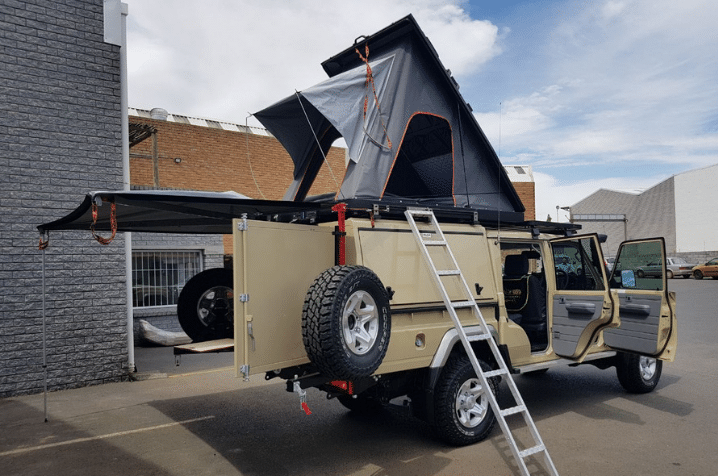
“The clamshell tents also allow you to store your bedding in the tent making early morning game viewing a quick and easy hop out and head out to that all-important sunrise start.”
“Another top modification was made on the Photographer Cruiser; this is the owner and founder of TechPro Safari’s dream vehicle. Dmitry is very focused on photography and wanted to give other photographers the opportunity to come in and hire a vehicle that they could use for the sole purpose of photography.”
“The vehicle is set up with a lot of equipment, more than I’ve seen in any other vehicle that you can hire. One of the custom modifications includes an electric operational sunroof, allowing you to stand up through the roof and take photos. Other equipment supplied specifically to this vehicle includes a Manfrotto tripod, a roof-rack photo camera mount slider, a dashboard gadget mount and a camera door mount.”
“The other vehicles all have a rear view camera with a monitor. In addition, the vehicles have a pure Sine Wave 800-watt inverter to charge camera batteries and plenty of USB power points to charge gadgets. The auxiliary battery system will allow you extended stays in remote areas taking power from the solar panel to charge the auxiliary battery. However, managing auxiliary battery power has to be understood to maximise your time when you are not driving your vehicle and charging your auxiliary battery.”
“The vehicle is ideal for two people allowing enough space for all your photography equipment to have a safe space on the rear seat and be locked away in the canopy at night.”
“Other modifications include the fact that they went ahead and fitted quality suspensions. Their choice of tyres is a top brand suitable for all terrain conditions in Africa. They include a GPS with a good size screen and Tracks 4 Africa mapping on the GPS as well as T4A maps and guidebooks for most of the popular destinations.”
To all explorers, adventurers and 4×4 enthusiast—this one’s for you.In this month’s final Interview with Paul Marsh, we take a deeper dive into his world of overland vehicle modification, customisation and builds. Paul also shares with us some helpful expedition preparation advice and a few more useful tips and facts to take with you on your overland adventure travel journey.
What’s your number one piece of advice on a self-drive safari in Africa?
“The most important aspect is to take on the responsibility of your own wellbeing. If you’re going to a company that’s just going to hand you the keys to a vehicle, you need to take an active role in preparing for your trip. Take on the responsibility of getting to know as much as you can about your trip ahead of time. Watch YouTube videos, speak to people and get some training so that when you head out on your trip, you have the confidence and knowledge to help yourself out of a situation instead of relying on someone else to help you. Be an independent traveller—the more independent you are, the more confident you’ll feel exploring remote areas.”
What’s the fundamental difference between hiring a 4×4 safari vehicle from a self-drive company and hiring one from a car rental service?
“When hiring a vehicle through a self-drive company like TechPro Safari, you are getting a bespoke service in planning your trip. It’s going to be a hand holding experience because not only are they going to help prepare your itinerary, they’re going to ensure that the experience you have with the vehicle, the training beforehand as well as the hand over procedure are what you need to carry out your trip in the best way possible. You are paying for this service so it’s important to know what to expect.”
“When you hire a vehicle from a car rental company, there’s less interaction with the client. They are not planning your trip; they don’t take on that responsibility and you are not paying for that service either. What is important is to know where you will be going and to ensure you have the correct equipment and experience to undertake this trip.”
“Some companies limit the equipment they supply and fit to vehicles; others charge extra for additional equipment like a winch or jerry cans. A lot of the time hiring a vehicle may come across as the cheaper option, but with all the added extras, you could land up paying more compared to a self-drive company’s vehicle, which has much higher specs and a lot more inclusions. Take a look at TechPro Safaris fleet for instance, all equipment is included by default, and there are no hidden costs. It’s your responsibility to make sure you have what you need.
“Sadly, people don’t know what they don’t know, and I use this term often. People go out and hire a vehicle from a rental company in total ignorance and trust that what they’re getting is what they should have. They go into it with no real experience, no real support and sometimes without the right equipment. All this could tarnish what could be an amazing experience.”

“If you’re looking to explore Africa, I think it’s important to look at your options; what are you prepared to spend and what are you getting out of your money. Ask yourself, what are your values and priorities. What are your needs, and what is your experience. Once you know your needs and wants, that’s when you can look at self-drive companies and compare them apart from hire companies. Your experience and your time available together with your budget are what you have to balance out to make good decisions.”
“With some hire companies, you can request to hire extra equipment like satellite phones. If they don’t supply this, then take responsibility and hire one from an outside company. Remember, you are in charge of your safety. My highest value is safety; I have seen where it all goes wrong; I have made life-threatening mistakes and bad decisions. It has taught me that more knowledge is critical to safety on any expedition. I will always travel with a satellite phone, I owe my life to one when I had a near fatal accident in South America, 4 days from the end of a 3-month expedition. Looking back on that event showed me how I lead myself into a set of circumstances that were heavily stacked against me.”
What base vehicle did you use for TechPro Safari’s fleet and why?
“TechPro Safari’s fleet is made up predominantly of the Toyota Land Cruiser 79 series with a recent addition of the Toyota Hilux.”

“When it came to building TechPro Safari’s fleet, we looked for the most reliable and robust vehicle. A vehicle with a good network of support and that was easy to maintain and repair. Toyota, in my opinion, fits this need, especially the Land Cruiser with the strong reliable and simple 4.2 L Diesel engine.”
“We chose the Double cab 79 series for space and load carrying ability. Fitting a canopy to the rear load area gives you easy access to all your equipment. Access is an important and convenient aspect to using your equipment with the least amount of fuss.”
“The Toyota Hilux was brought in to provide clients with the option of hiring an automatic vehicle—because we don’t get automatics in the double cab Land Cruisers. So, the Hilux fills a niche in the market, and they’re great vehicles, just not as strong and robust as the double cab Land Cruiser. We applied a similar approach to fitting out the load area of the Hilux. With a smaller canopy, you have less space to carry extra luggage, so in my opinion, the Hilux is great for 3 people. The automatic gearbox will perform exceptionally well in difficult conditions. Driving the Hilux will be more like an SUV and as capable as the Land Cruiser.

You built and continue to add to TechPro Safaris fleet. What were some of the top modifications made to their vehicles?
“There are a few I will mention. For one, they’ve put some great rooftop tents, specifically the clamshell design which takes all of 60 seconds to set up. This model of tent allows us to fit a solar panel which adds extra charge into the auxiliary battery as well as fit a set of recovery Max Trax to the top of it for easy access when stuck in sand or mud. “

“The clamshell tents also allow you to store your bedding in the tent making early morning game viewing a quick and easy hop out and head out to that all-important sunrise start.”
“Another top modification was made on the Photographer Cruiser; this is the owner and founder of TechPro Safari’s dream vehicle. Dmitry is very focused on photography and wanted to give other photographers the opportunity to come in and hire a vehicle that they could use for the sole purpose of photography.”
“The vehicle is set up with a lot of equipment, more than I’ve seen in any other vehicle that you can hire. One of the custom modifications includes an electric operational sunroof, allowing you to stand up through the roof and take photos. Other equipment supplied specifically to this vehicle includes a Manfrotto tripod, a roof-rack photo camera mount slider, a dashboard gadget mount and a camera door mount.”
“The other vehicles all have a rear view camera with a monitor. In addition, the vehicles have a pure Sine Wave 800-watt inverter to charge camera batteries and plenty of USB power points to charge gadgets. The auxiliary battery system will allow you extended stays in remote areas taking power from the solar panel to charge the auxiliary battery. However, managing auxiliary battery power has to be understood to maximise your time when you are not driving your vehicle and charging your auxiliary battery.”
“The vehicle is ideal for two people allowing enough space for all your photography equipment to have a safe space on the rear seat and be locked away in the canopy at night.”
“Other modifications include the fact that they went ahead and fitted quality suspensions. Their choice of tyres is a top brand suitable for all terrain conditions in Africa. They include a GPS with a good size screen and Tracks 4 Africa mapping on the GPS as well as T4A maps and guidebooks for most of the popular destinations.”
Tell us a bit more about the modifications you made on TechPro Safari’s Photographer Cruiser? Were there any challenges?
“The biggest challenge for us was creating an outside photography section on the roof of the double cab Toyota Land Cruiser.”

“In order for us to fit a roof that someone could stand up through it had to be electrical—so an electric roof that could slide back allowing enough space to stand up through. I had to find another vehicle with a donor electric roof; it was fortunate that our body shop at the time had an electric roof from another model that we could use. So, we removed the whole roof of TechPro Safari’s Land Cruiser and replaced it with the donor roof which had the electric roof built in. The new roof had to be resprayed, and new roof lining had to be installed—this was the biggest and most challenging modification for the customisation of the Photographer Cruiser, quite an expensive modification too.”
Can you give us a little more insight into TechPro Safari’s fleet design and onboard equipment?
“Having the Toyota Land Cruiser and Hilux as the base vehicles of TechPro Safari’s fleet allowed us to install a canopy on the back. Our goal was to give people access to equipment and storage in different areas. One of the areas we implemented was a built-in kitchen which consists of drawers, a water tank and a fridge—which on a long trip is nice to have access to.”
“The vehicles (excluding the photography vehicles) can accommodate up to 4 people. Each vehicle includes a ground tent and rooftop tent. As mentioned, the Hilux vehicle space is premium and can comfortably accommodate up to 3 adults or 2 adults and 2 small children.”
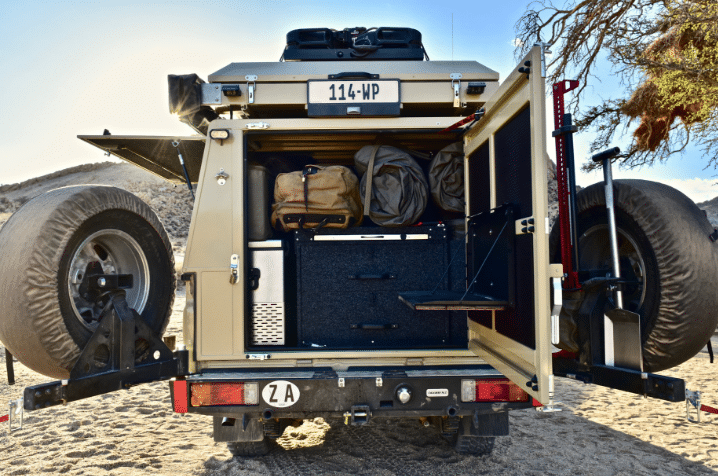
“There are also various compartments and areas where recovery equipment is stored. There is a very comprehensive recovery kit including a winch and hi-lift jack. I must say any recovery operation is dangerous and knowing how to use this equipment is critical to your safety.”
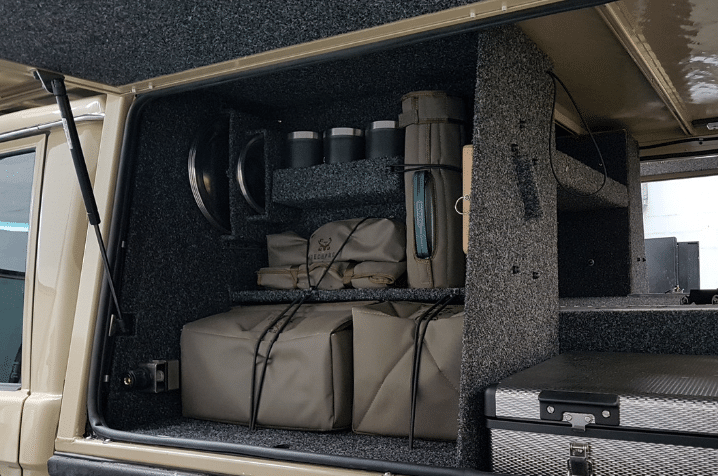
“When we sat down and decided on what equipment to fit on the vehicles; from the equipment itself to its protective bags, no expense was spared in choosing good quality, usable equipment.”
“Safety, as mentioned, is my highest value and can never be stressed enough. TechPro Safari has taken this into consideration. When I look at TechPro Safari’s fleet, I’m proud of the fact that each vehicle is well built, with high specs and enhanced safety features. A big thanks goes out to the owner Dmitry, who was prepared to listen and take good advice from hard learned experience and lessons.”
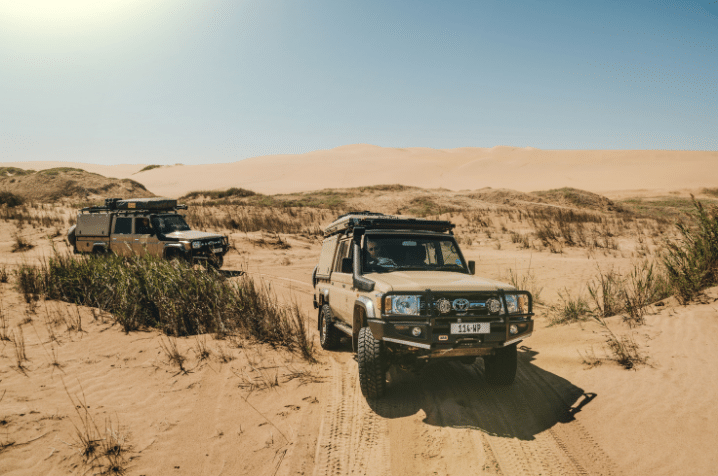
An overlanding vehicle is not just any vehicle; it’s an all-weather, off-road, off-grid tiny house on four wheels ready for some serious adventure. And for those of you who have yet to explore Africa, we’re here to tell you that Africa is, without any exaggeration, one of the most unique experiences on earth. We hope this Interview series with Paul Marsh inspires you to go out on your own adventure travel journey in Africa.

